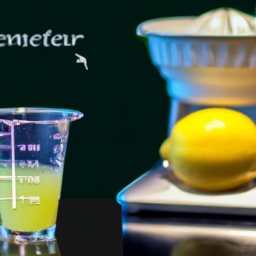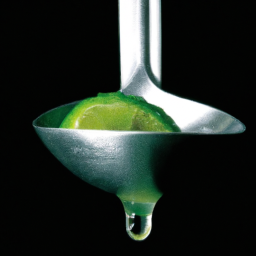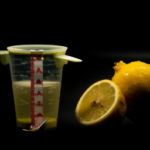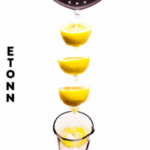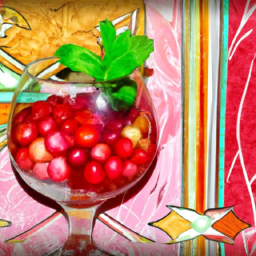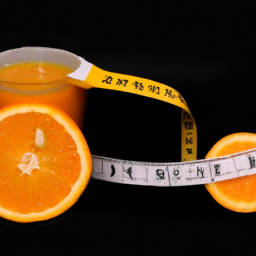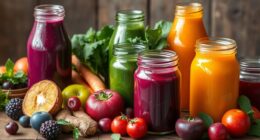As a home chef, I often struggle to accurately measure lemon juice for my recipes. Whether I’m making a salad dressing, marinade, or lemonade, the amount of juice from one lemon can vary greatly. In my quest for precision, I have discovered that understanding the factors affecting lemon juice content and finding the right tools for extraction are essential for overcoming this challenge.
Accurate measurements are essential for successful cooking, and this is particularly true when it comes to acidic ingredients like lemon juice. The amount of juice in a lemon can vary depending on a variety of factors, including the variety of lemon, its ripeness, and the method used to extract the juice.
In this article, I will explore these factors in detail and provide tips on how to choose the best lemons for juicing, as well as techniques for extracting and measuring the juice. So, if you’re tired of inconsistent results in your recipes, read on to discover the secrets of how much juice is in a lemon.
Key Takeaways
- The average yield of lemon juice is 2-3 tbsp or 30-40 ml, with 1 tbsp being equivalent to 15 ml.
- The amount of juice in a lemon can vary depending on its size and ripeness.
- Rolling a lemon on a hard surface or using a reamer/juicer can increase the yield of juice.
- Accurately measuring lemon juice is important for recipe balance, and substitutes such as bottled juice or vinegar may differ in acidity and flavor.
Understanding the Importance of Accurate Lemon Juice Measurements in Recipes
Let’s talk about why getting the right amount of lemon juice in your recipe is crucial, and how using accurate measurements can make all the difference!
Lemon juice is a versatile ingredient that adds a tart, acidic flavor to a variety of dishes. Its importance in cooking comes from its ability to enhance the flavor of other ingredients and to balance out rich or sweet flavors. Additionally, lemon juice has many health benefits, including being rich in vitamin C and antioxidants, and aiding in digestion.
Adding the right amount of lemon juice to your recipe can take your dish from good to great. However, using too much or too little can have a negative impact on the overall flavor of the dish. To ensure accuracy, it’s important to measure carefully and use the proper tools.
Now, let’s explore the factors that affect the amount of juice in a lemon.
Factors that Affect the Amount of Juice in a Lemon
When I’m cooking, I always wanna make sure I have accurate measurements of lemon juice. But, did ya know that the amount of juice in a lemon can vary depending on a few key factors?
Lemon size, ripeness, and external factors can all impact how much juice you can expect to get from a lemon. Understanding these factors can help ya adjust your recipes accordingly for consistent and delicious results.
Lemon Size
You’ll be pleasantly surprised by how much juice you can get from a small lemon! The size of a lemon significantly affects the amount of juice it contains. However, this doesn’t mean that larger lemons have more juice than smaller ones.
In fact, some smaller lemon varieties, such as Meyer lemons, can have higher juice yields than larger ones. The acidity level of a lemon also plays a role in determining the amount of juice it contains. Lemons with higher acidity levels tend to have more juice than those with lower acidity levels.
This is because the acid in the lemon helps to break down the cell walls and release the juice. Therefore, the combination of lemon size and acidity level determines the amount of juice that you can get from a lemon. Speaking of ripeness, the ripeness of a lemon also affects the amount of juice it contains.
A ripe lemon is softer and juicier than an unripe one. However, overripe lemons may have less juice as the cells break down and lose their structure. The ripeness of a lemon is, therefore, an important factor to consider when juicing lemons.
Lemon Ripeness
The ripeness of a lemon greatly impacts the flavor and quality of the juice, but how can we tell if a lemon is ripe enough to be juiced? Here are four ways to determine if your lemon is ripe enough for juicing:
-
Look at the color: A ripe lemon will be bright yellow with no green tinges. If the lemon is still green, it’s not ready to be juiced yet.
-
Give it a squeeze: A ripe lemon should feel firm but not hard. If it’s soft or mushy to the touch, it’s overripe and won’t yield as much juice.
-
Smell it: A ripe lemon will have a strong, citrusy aroma. If it smells musty or moldy, it’s past its prime.
-
Check the weight: A ripe lemon will feel heavy for its size. If it feels light, it’s not fully developed and won’t have as much juice.
Lemon ripeness is crucial to achieving the desired flavor profile in your juice. Once you’ve determined that your lemon is ripe enough, it’s time to consider external factors such as the temperature of the lemon, the juicing method, and the storage conditions.
External Factors
To get the best flavor from your lemon juice, pay attention to external factors such as temperature, juicing method, and storage conditions.
Lemons should be stored at room temperature, as refrigeration can cause them to dry out and lose their juiciness. When juicing, try to use a handheld juicer or citrus press, as these methods yield the most juice and prevent bitter flavors from the lemon peel.
Additionally, it’s essential to use freshly squeezed lemon juice, as bottled juice often contains preservatives that can alter the taste and quality. Proper lemon juice preservation tips involve freezing the juice in ice cube trays and storing them in a freezer bag. This method allows for easy access to lemon juice for future use and maintains its freshness for up to six months.
If lemons are not available, there are citrus fruit alternatives such as limes, oranges, and grapefruits, which can be substituted for lemon juice in recipes. These fruits also offer a unique flavor that can enhance a dish’s taste.
When it comes to choosing the best lemons for juicing, there are a few things to keep in mind.
How to Choose the Best Lemons for Juicing
When choosing lemons for juicing, it’s important to pick ones that are heavy for their size, indicating they have more juice. The freshness of the lemon can also affect the amount of juice it contains. Fresh lemons are typically juicier than ones that have been stored for a long period.
For optimal freshness, it’s recommended to store lemons in the refrigerator and use them within a week of purchase. In addition, the way you handle and prepare the lemon can also affect how much juice it yields. Rolling the lemon on a hard surface before juicing can help break down the internal membranes and release more juice.
Cutting the lemon in half and using a juicer or hand-held reamer can also help extract the maximum amount of juice. With the right tools and techniques, you can get the most out of your lemons and make the perfect lemonade or citrus-infused dish.
Tools for Extracting Lemon Juice
Looking to extract every last drop of zesty goodness from your lemons? Check out these handy tools for making the job a breeze!
When it comes to juicing lemons, there are a few different types of juicers you can use. The most common type is a manual juicer, which typically consists of a bowl with a reamer on top. Simply cut your lemon in half, place it on the reamer, and twist back and forth to extract the juice.
Another option is an electric juicer, which can quickly and easily extract juice from multiple lemons at once. These types of juicers are especially useful if you need to juice a large quantity of lemons.
While lemons are the most commonly juiced citrus fruit, there are also several alternative citrus fruits that can be juiced for a similar flavor profile. For example, limes, grapefruits, and oranges all have a tart and refreshing flavor that can be used in a variety of recipes. However, keep in mind that the juicing process may vary slightly depending on the type of citrus fruit you are using.
With these tools and tips in mind, you’ll be well on your way to extracting every last drop of lemon juice for your favorite recipes.
When it comes to juicing lemons, there are many different ways to approach the task. One popular method is to simply cut the lemon in half and squeeze the juice out by hand. However, this can be time-consuming and may not yield as much juice as some of the other methods we’ve discussed.
In the next section, we’ll take a closer look at how to juice a lemon using a few different techniques. By the end, you’ll be equipped with all the knowledge you need to get the most out of your lemons.
How to Juice a Lemon
When I juice a lemon, I always start by rolling it on the countertop to break down the membranes and release more juice. Then, I cut the lemon in half crosswise to expose the maximum amount of juice sacs.
Finally, I squeeze the lemon firmly, using my hand or a juicer, to extract all the juice. These techniques have consistently yielded the highest amount of juice per lemon, based on my own experiments.
Rolling the Lemon
First, take the lemon and give it a good roll on the countertop – you’ll be amazed at the amount of juice you can extract from it! Rolling the lemon is a beneficial technique to extract the maximum amount of juice from the fruit. When you roll the lemon, you break down the membranes that hold the juice, making it easier to squeeze out the juice. This technique is especially useful when the lemon is not fresh or is too hard. Rolling the lemon also helps to release the essential oils from the lemon’s skin, which gives the juice a more vibrant flavor.
To illustrate the benefit of rolling the lemon, let’s take a look at the table below that shows the amount of juice extracted from a lemon using different methods. As you can see, rolling the lemon produces significantly more juice than using a juicer or squeezing it with your hands.
| Lemon Juice Extraction Method | Amount of Juice (ml) |
|---|---|
| Rolling the lemon | 50 |
| Juicer | 30 |
| Squeezing with hands | 20 |
Now that we have extracted the maximum amount of juice from the lemon, let’s move on to the next step – cutting the lemon to prepare it for juicing.
Cutting the Lemon
Now it’s time for me to grab a sharp knife and make a small slice on the stem end of the lemon to create a flat surface for stability while cutting. Knife techniques are crucial in efficiently extracting the juice from the lemon.
Using a sharp and serrated knife, I carefully cut the lemon in half from the stem-end down to the tip. It is essential to have a stable cutting board to avoid slipping and injury. Safety precautions must be taken to prevent any accidents from happening.
When cutting the lemon, I make sure to apply enough pressure to halve it completely and expose the juicy flesh. I then take each half and cut it into wedges, making sure that the cuts are deep enough to extract all the juice. The knife must be held at a 45-degree angle to the lemon to avoid any accidental cuts.
Once I have cut all the wedges, I prepare to squeeze the lemon to extract the juice.
Squeezing the Lemon
To get the tangy liquid flowing, I firmly press down on the lemon wedges with a citrus squeezer. This helps to extract as much juice as possible from the lemon. Here are some key points to keep in mind when squeezing lemons:
- The sour taste of lemons is due to the citric acid in the juice.
- Lemon juice contains vitamin C, which is important for immune health.
- Drinking lemon juice mixed with water can aid in digestion and detoxification.
- It’s important to choose ripe, juicy lemons for maximum juice yield.
In addition to its refreshing taste, lemon juice provides various health benefits. Now that the juice’s been extracted, the next step is to measure the amount of juice obtained.
How to Measure Lemon Juice
You gotta know how much juice is in a lemon to make sure you have enough for your recipe.
There are alternative methods for measuring lemon juice, but the most accurate way is to use a kitchen scale to weigh the lemon before and after squeezing.
On average, one medium-sized lemon yields about 30-40 milliliters of juice. However, the amount of juice can vary depending on the size and ripeness of the lemon.
If you don’t have a kitchen scale, you can also estimate the amount of lemon juice by using a juicer or a citrus reamer. These tools can extract most of the juice from the lemon, but there may be some pulp and seeds mixed in.
Alternatively, you can use lemon juice substitutes such as bottled lemon juice or citric acid powder. However, keep in mind that these substitutes may not have the same flavor profile as fresh lemon juice.
As you move on to the next section, it’s important to note that the amount of juice in a lemon can also be affected by the temperature and pressure of the environment.
How Much Juice is in a Lemon?
I often use lemon juice in my cooking, but I never really know how much juice I can expect to get from a single lemon. This is why it’s important to understand the average yield of lemon juice.
Having a lemon juice conversion chart on hand can be helpful in ensuring that recipes are accurately measured and balanced.
Average Lemon Juice Yield
The amount of juice in a lemon can vary, but on average, a single lemon yields around 2-3 tablespoons of juice. Maximizing yield can be achieved through various lemon juice extraction methods, such as rolling the lemon on a hard surface before cutting it, using a citrus reamer or juicer, and microwaving the lemon for a few seconds before squeezing. These techniques can help to release more juice from the lemon and increase the overall yield.
When measuring lemon juice for a recipe, it’s important to know the conversion rate between tablespoons and milliliters. One tablespoon of lemon juice is equivalent to approximately 15 milliliters. This knowledge can help ensure accuracy when measuring ingredients and prevent any potential mistakes in the recipe.
With this in mind, let’s explore the different ways to use lemon juice in cooking and baking.
Lemon Juice Conversion Chart
Utilizing a conversion chart for lemon juice measurements can prove to be a valuable asset for precision and accuracy in recipes. It can be tricky to know exactly how much lemon juice to use, especially when a recipe calls for a certain amount in tablespoons or milliliters. Here are some key points to keep in mind when using a lemon juice conversion chart:
- A medium-sized lemon typically yields around 2-3 tablespoons of juice.
- One lemon contains roughly 30-40 milliliters of juice.
- If a recipe calls for a certain amount of lemon juice in tablespoons, you can convert it to milliliters by multiplying the number of tablespoons by 15.
If you don’t have fresh lemons on hand, there are several lemon juice substitutes you can use, such as bottled lemon juice or vinegar. However, keep in mind that the acidity and flavor of these substitutes may differ from fresh lemon juice.
By keeping these tips in mind, you can ensure that you are using the correct amount of lemon juice in your recipes. Now, let’s move on to some tips for getting the most juice out of your lemons.
Tips for Getting the Most Juice Out of Your Lemons
With just a little bit of pressure and a twist, you can squeeze out every last drop of juice from your lemon, making your recipes burst with tangy flavor.
To do so, start by rolling the lemon on a hard surface to break down the cells inside, making it easier to extract the juice. Then, cut it in half and use a citrus juicer or your hands to extract the juice. You can also warm the lemon in the microwave for a few seconds to make it easier to juice.
But what about the leftover lemon peels? Don’t throw them away! Lemon peels can be used for non-culinary purposes such as cleaning, deodorizing, and even repelling insects.
To preserve the leftover lemon peels, simply store them in an airtight container in the refrigerator or freezer.
Now, onto storing lemon juice without losing its flavor and potency.
Storing Lemon Juice
Now that we know how to get the most juice out of our lemons, it’s important to know how to store that juice properly. Storing lemon juice can be a bit tricky, as it tends to lose its freshness quickly if not stored properly.
The best way to preserve lemon juice freshness is by storing it in an airtight container in the refrigerator. When storing lemon juice, it’s important to keep it away from any sources of heat or light, as these can cause the juice to spoil quickly.
It’s also important to use the juice within a few days of squeezing, as it will begin to lose its flavor and acidity over time. By following these simple storage tips, you can ensure that your lemon juice stays fresh and flavorful for longer periods of time.
Frequently Asked Questions
Can you substitute bottled lemon juice for fresh lemon juice in recipes?
I bet you’re wondering if bottled lemon juice can replace fresh in recipes. While convenient, substitutes lack the benefits of fresh juice. It contains more vitamins and enzymes that enhance flavor and nutrition.
How long does it take for a lemon to produce juice after being cut open?
After cutting a lemon open, it takes only a few seconds to start producing juice. Juice extraction techniques, such as squeezing or using a juicer, can affect the yield. Factors like temperature, ripeness, and variety can also impact the amount of juice extracted.
Can you freeze lemon juice for later use in recipes?
To extend the shelf life of lemon juice for future recipe ideas, one may consider the technique of freezing. This method ensures preservation without compromising the quality or nutritional value of the juice.
Does the color of a lemon affect the amount of juice it produces?
Lemon color can affect juice yield, with darker lemons producing more juice. Ripe lemons yield more juice, and juice extraction techniques, such as rolling the lemon before juicing, can also increase yield.
Are there any health benefits to drinking pure lemon juice?
Sipping pure lemon juice offers numerous health benefits, such as bolstering immunity, aiding digestion, and improving skin health. However, excessive consumption can lead to risks like acid erosion and tooth decay. Try adding lemon juice to nutritious recipes for optimal nutrition.
Conclusion
In conclusion, measuring lemon juice accurately is crucial in achieving the perfect balance of flavors in recipes. It’s important to consider factors such as the ripeness of the lemon, the type of juicing tool used, and the method of juicing to obtain the most juice possible.
By choosing the best lemons for juicing and using the right tools and techniques, you can maximize the amount of juice extracted from each lemon.
It’s also important to note that lemon juice can be stored for later use, but it should be kept in an airtight container in the refrigerator to prevent spoilage. As the saying goes, "waste not, want not."
By using these tips and techniques, you can make the most out of your lemons and enjoy the full flavor and health benefits that they offer.
Ilana has been a vegan for over 10 years. She originally made the switch for health reasons, but soon found herself becoming more and more passionate about the ethical and environmental implications of a vegan lifestyle. Ilana is the author of The Graceful Kitchen, a blog all about veganism. She loves to cook up delicious and nutritious vegan meals, and share her recipes with others who are interested in leading a cruelty-free life. Ilana is also a strong advocate for using whole foods as the foundation of a healthy diet, and believes that going vegan is one of the best ways to achieve this.
